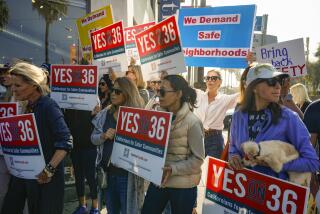A polarized, paralyzed state
- Share via
FROM SACRAMENTO — California’s dysfunctional Legislature is largely the result of a dysfunctional election system.
The system is geared to elect ideologues, not pragmatists -- liberals and conservatives, rather than moderates. That, combined with two voter-injected poisons -- term limits and the two-thirds vote requirement -- is what increasingly has led to legislative gridlock.
This isn’t news to a lot of folks, although not everyone agrees with all of it, especially the two-thirds vote absurdity.
But a comprehensive report released last week by the nonpartisan Field Poll offers evidence that the two major parties in California -- particularly the Republican -- have been moving toward the extremes.
They nominate ideologues who easily win in November and contribute to political polarization and paralysis in Sacramento.
Factor in the inexperience, weak leadership and job-hopping insecurity induced by term limits, plus the super-hurdle of a two-thirds vote needed for budgets or tax increases, and it’s a wonder anything of importance gets done in Sacramento.
The 62-year-old Field Poll gleaned data from several recent statewide surveys and compared it with surveys conducted in the mid- to late 1970s.
Among other things, Field reported that on two social issues -- same-sex marriage and euthanasia -- Democrats have veered further left and Republicans have moved right. Basically, Democrats have become more tolerant on these issues; Republicans less.
On same-sex marriage, only 29% of Democrats approved of it in 1977, but 64% do today. Among Republicans, 30% approved back then; only 23% now. There’s a similar pattern for euthanasia: Among Democrats, 60% were OK with it in 1975; 80% are today. For Republicans, support has slipped from 66% to 59%.
Poll director Mark DiCamillo ran other numbers for me comparing ideological intensity in 1992 -- the first year he began asking the question -- with today’s. In 1992, 17% of Democrats said they were “strongly” liberal. That since has risen to 24%. The figures are more dramatic for Republicans: 28% described themselves as “strongly” conservative in 1992. Now 41% do.
What’s going on is that moderates have been abandoning the two major parties and registering as nonpartisan independents, or “Decline to State.” In 1978, about 8% of voters were independents. In 1992, it was 10%. Today it’s 20%.
“The fastest growing segments of non-partisans are Latinos and Asians,” DiCamillo says. “We’re talking about first-generation citizens with few ties to a party.”
Another reason for rejecting the parties, the pollster says, “is the hyper-partisanship nationally and in California. Younger voters are turned off by the failure of politicians to compromise.”
He adds: “You can’t turn on the radio without hearing the flamethrowers. You’ve got the Republican cable network and the Democratic network. Look at what’s going on in the health debate. It’s all partisan warfare, not a discussion of healthcare. It turns people off to politics generally.”
Among independents, 51% call themselves “middle-of-the-road,” DiCamillo reports. Of Democrats, 45% do. But only 35% do among Republicans. The GOP, especially, is left with a dominant base of ideological hard-liners to nominate candidates in primaries.
Independents may vote in either a Democratic or Republican state primary, but relatively few do, says Allan Hoffenblum, publisher of the California Target Book, which handicaps legislative races.
“Most independents don’t know they can vote in a primary,” he says. “It’s very complicated. And campaigns don’t go after them.”
So party purists nominate the legislative candidate who reflects their doctrinaire views. And in November, because the vast majority of districts have been gerrymandered by the Legislature to prevent competition and protect the political status quo, the ideologue is dispatched to Sacramento for more stalemate.
Of all registered voters, 43% are middle-roaders. But that moderation isn’t reflected in the Legislature.
Solutions:
* An “open primary.” Next June, there’ll be a measure on the ballot to have everyone -- voters and candidates -- participate in the same primary. The top two voter-getters, regardless of party, would advance to the November election. The goal is to force primary candidates to appeal to a broader range of voters and run closer to the middle.
* Deny legislators the right to draw their own districts. Voters already did that last November. And after the 2010 elections, new districts will be drawn by an independent commission, hopefully making several seats more competitive.
News coverage of the Field report focused on the GOP’s failure over the decades to keep pace with California’s changing demographics: a declining white electorate, a rapidly increasing population of Latinos and Asians. It doesn’t bode well for the party’s future.
“There are so many ‘Declined to State’ voters of color,” says Hoffenblum, a former Republican consultant. “They’re turned off by the Republican Party because they think it’s a white man’s club.”
Of today’s registered voters, 65% are white and 21% Latino, almost three times the Latino percentage in 1978. But Republican registration is 79% white and only 13% Latino. Democrats are 55% white and 27% Latino. Meanwhile, the GOP share of the electorate is down to 31%. Democrats have 45%.
Asians represent roughly 8% of registered voters, nearly three times their number in 1978, and now account for 16% of independents.
To some extent, ethnic diversity even contributes to gridlock. With greater diversity comes more complexities, competing agendas and need for broader coalitions, particularly when two-thirds votes are required.
We need to dismantle the system to end the dysfunction.
--
More to Read
Get the L.A. Times Politics newsletter
Deeply reported insights into legislation, politics and policy from Sacramento, Washington and beyond. In your inbox twice per week.
You may occasionally receive promotional content from the Los Angeles Times.











